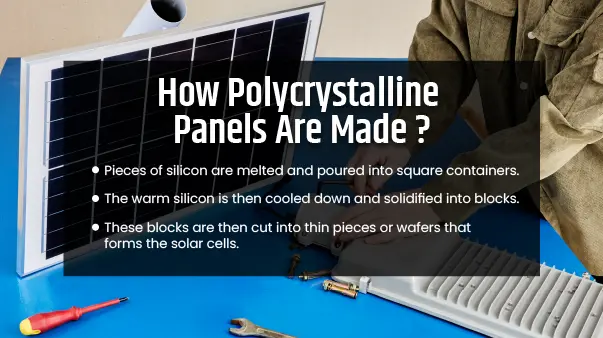Polycrystalline Solar Panels
Polycrystalline solar panels play a vital role in the sustainable energy strategy. These panels stand out due to their cheap price and utility, as these can be used for different energy needs. They are made of melted silicon pieces, which gives them a blue coloured speckled look.
Polycrystalline solar panels are more efficient than other types of panels when it comes to the method of production, as lesser waste and production costs need to be incurred. This efficiency helps make them more widely used in both domestic and commercial installations.
How Polycrystalline Panels Are Made

Making polycrystalline panels is a very simple process that involves the following steps:
- Pieces of silicon are melted and poured into square containers.
- The warm silicon is then cooled down and solidified into blocks.
- These blocks are then cut into thin pieces or wafers that forms the solar cells.
This simple manufacturing method serves the twin purpose of lessening waste and hence cost of these panels. Though these panels are cheaper, it does not affect the reliable energy output afforded to various applications.
Benefits of Polycrystalline Panels
Cost-Effectiveness
- Polycrystalline panels being less complex in their construction leads to cheaper production costs.
- These solar panels can be easily availed by ordinary home owners and business entities looking for a more affordable source of energy.
Polycrystalline panels are well built, enabling long-term use even in extreme conditions. Start glazing your polycrystalline solar panels as they are built to withstand heavy snowfall and strong winds.
Energy Efficiency
- Start glazing your polycrystalline panels as they provide a perfect balance between performance and cost. With an efficiency of 15-17%, these panels are guaranteed to be a good medium for buyers and sellers.
- Helps ease the energy from medium to larger ranges of homes all the way to industrial facilities.
These panels are sturdy and can endure at least a few decades of service, even though monocrystalline panels are slightly more efficient, polycrystalline will always be an economical choice for renewable energy options.
Versatility
- Polycrystalline are used in a number of places such as rooftops where they can help decrease carbon emissions and electricity expenses.
- These panels are modular allowing commercial grade clients to place large scale orders to meet energy requirements.
This adaptability means that most customers have a practical problem.
Use in Off-Grid Systems
Polycrystalline panels are a trustworthy source of energy for off-grid set ups. They are extraordinarily useful in locations that do not have access to the grid. These panels can be used for:
- Water pumps for agricultural purposes.
- Telecommunication devices needed for unfriendly remote terrains.
- Powering cabins and buildings located in remote areas.
These panels can be used globally in challenging conditions with most customers having a practical solution.
Polycrystalline Panels Comparison with Other Panels
Monocrystalline Panels
- Even though polycrystalline panels can be a preferred solution for many, they are still considered to be less powerful than the monocrystalline panels.
- Although monocrystalline panels are costly, they do have a higher efficiency of greater than 20%.
To those who are looking for lower costs over high-efficiency, polycrystalline panels are a great option.
Thin-Film Panels
- Thin film panels are less efficient at 10%-12%, however they do have the advantage of being lightweight and flexible.
- Unlike polycrystalline panels, they do need more installation space.
In situations when space is an issue, polycrystalline panels are a better option for performance and cost.
Installation and Maintenance
Appropriate installation and maintenance of polycrystalline panels are vital to achieve optimal performance. The following steps should be observed:
Installation:
- Position panels in locations that will get the sunniest sort of light available.
- Set maximum tilt angles to the area you are located at.
-Maintenance:
- Regularly wash the panels to get rid of dirt and dust.
- Check for damaged panels and loose fittings on a regular basis.
- Use monitoring systems to see energy generated and check for any early signs of issues.
Following these steps ensure that the solar panel system will be functional and efficient for years to come.
Polycrystalline solar panels are cost effective, long lasting, and environmentally friendly. Beside their characteristics such as reliability and versatility, they are suitable for residential, off-grid, commercial applications. These panels are an investment for a sustainable energy future.
